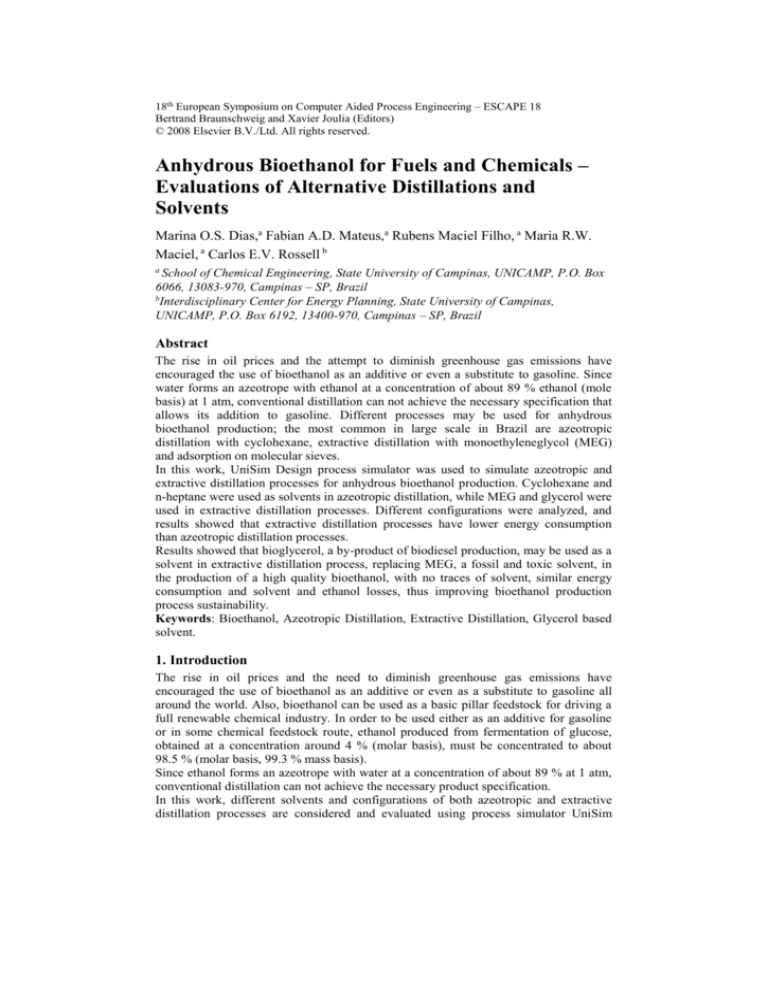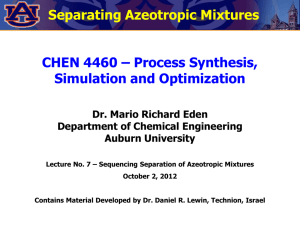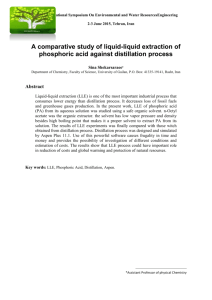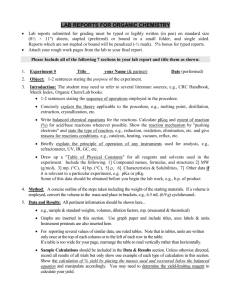
18th European Symposium on Computer Aided Process Engineering – ESCAPE 18
Bertrand Braunschweig and Xavier Joulia (Editors)
© 2008 Elsevier B.V./Ltd. All rights reserved.
Anhydrous Bioethanol for Fuels and Chemicals –
Evaluations of Alternative Distillations and
Solvents
Marina O.S. Dias,a Fabian A.D. Mateus,a Rubens Maciel Filho, a Maria R.W.
Maciel, a Carlos E.V. Rossell b
a
School of Chemical Engineering, State University of Campinas, UNICAMP, P.O. Box
6066, 13083-970, Campinas – SP, Brazil
b
Interdisciplinary Center for Energy Planning, State University of Campinas,
UNICAMP, P.O. Box 6192, 13400-970, Campinas – SP, Brazil
Abstract
The rise in oil prices and the attempt to diminish greenhouse gas emissions have
encouraged the use of bioethanol as an additive or even a substitute to gasoline. Since
water forms an azeotrope with ethanol at a concentration of about 89 % ethanol (mole
basis) at 1 atm, conventional distillation can not achieve the necessary specification that
allows its addition to gasoline. Different processes may be used for anhydrous
bioethanol production; the most common in large scale in Brazil are azeotropic
distillation with cyclohexane, extractive distillation with monoethyleneglycol (MEG)
and adsorption on molecular sieves.
In this work, UniSim Design process simulator was used to simulate azeotropic and
extractive distillation processes for anhydrous bioethanol production. Cyclohexane and
n-heptane were used as solvents in azeotropic distillation, while MEG and glycerol were
used in extractive distillation processes. Different configurations were analyzed, and
results showed that extractive distillation processes have lower energy consumption
than azeotropic distillation processes.
Results showed that bioglycerol, a by-product of biodiesel production, may be used as a
solvent in extractive distillation process, replacing MEG, a fossil and toxic solvent, in
the production of a high quality bioethanol, with no traces of solvent, similar energy
consumption and solvent and ethanol losses, thus improving bioethanol production
process sustainability.
Keywords: Bioethanol, Azeotropic Distillation, Extractive Distillation, Glycerol based
solvent.
1. Introduction
The rise in oil prices and the need to diminish greenhouse gas emissions have
encouraged the use of bioethanol as an additive or even as a substitute to gasoline all
around the world. Also, bioethanol can be used as a basic pillar feedstock for driving a
full renewable chemical industry. In order to be used either as an additive for gasoline
or in some chemical feedstock route, ethanol produced from fermentation of glucose,
obtained at a concentration around 4 % (molar basis), must be concentrated to about
98.5 % (molar basis, 99.3 % mass basis).
Since ethanol forms an azeotrope with water at a concentration of about 89 % at 1 atm,
conventional distillation can not achieve the necessary product specification.
In this work, different solvents and configurations of both azeotropic and extractive
distillation processes are considered and evaluated using process simulator UniSim
2
M.O.S. Dias et al.
Design. In all cases, the processes are simulated considering production of 1000 m³/day
of anhydrous bioethanol and optimal operating conditions. The use of an alternative
solvent, bioglycerol, a byproduct of biodiesel production, is proposed and its behavior is
evaluated in terms of energy consumption and ethanol and solvent losses.
2. Azeotropic Distillation
Simulations of Azeotropic Distillation processes were carried out using the well known
NRTL as the activity coefficient model for the liquid phase and the equation of state
SRK for the vapor model. Stage numbering increases towards the top of the columns.
Binary coefficients between solvent and water are not available at UniSim database and
must be estimated. In the decanter, the estimation method used was UNIFAC-LLE,
while in the other parts of the simulation UNIFAC-VLE was considered. An extensive
thermodynamic behavior study was made and the comparison with experimental data
showed that these models are suitable ones.
In the azeotropic distillation process, a solvent-rich solution is supplied on the top of the
azeotropic column, and hydrated bioethanol (liquid phase) and alcohol recycle are
supplied in a stage below the top. On the top of the azeotropic column, a ternary
azeotrope is obtained, while anhydrous bioethanol is withdrawn at the bottom. The
ternary azeotrope is cooled and two liquid phases are obtained in the decanter: an
organic phase, which is recycled to the azeotropic column, and an aqueous phase, which
is separated in the recovery column. At the top of the recovery column, an alcoholic
solution is obtained and recycled to the azeotropic column, while nearly pure water is
obtained at the bottom. A solvent make-up stream is supplied in order to recover some
solvent lost. Process configuration is shown in Figure 1.
Figure 1: Configuration of Azeotropic Distillation process.
Two different solvents were studied for anhydrous bioethanol production by azeotropic
distillation: cyclohexane and n-heptane. The anhydrous bioethanol produced by
azeotropic distillation contains traces of solvent. If the bioethanol is to be used as an
additive for gasoline, traces of n-heptane would not affect the quality of the blend, in
contrast with traces of cyclohexane.
In the process with n-heptane, a different configuration was studied. It consists of
another condenser on top of the azeotropic column. The best conditions were verified in
this configuration.
Anhydrous Bioethanol for Fuels and Chemicals – Evaluation of Alternative Distillations
and Solvents
3
A study of the optimal feed stage and temperature in the decanter for each process was
made. In Table 1, parameters are presented for the azeotropic distillation with
cyclohexane and n-heptane, as well as with n-heptane with azeotropic condenser.
Table 1: Parameters for the azeotropic distillation process with cyclohexane and n-heptane, and nheptane with condenser(*) in the azeotropic column.
Parameter
Cyclohexane
n-Heptane
n-Heptane*
Number of stages - Azeotropic Column
30
35
30
Solvent-rich solution feed stage
30
35
30
Solvent temperature (°C)
50
30
30
Hydrated Bioethanol feed stage
26
28
24
Solvent-rich solution flow (kmol/h)
6156
4620
2725
Hydrated Bioethanol flow (kmol/h)
850
850
850
Alcohol recycle flow (kmol/h)
4916
2345
1921
Anhydrous Bioethanol flow (kmol/h)
723
723
723
Azeotropic Column Bottom Temperature (°C)
78
78.1
78.1
Number of stages - Recovery Column
16
23
23
Heavy phase feed stage
14
13
13
Water in water stream (% mol)
99.9
99.9
99.9
Recovery Column Reflux Ratio
0.75
2
2
Recovery Column Bottom Temperature (°C)
99.4
99.7
99.7
Azeotropic Column Reboiler Duty (kW)
111,116
84,435
90,993
Recovery Column Reboiler Duty (kW)
96,175
80,957
66,375
Bioethanol losses (%)
0.017
0.017
0.017
Solvent losses (%)
0.001
0.003
0.008
Simulations showed that n-heptane is an interesting option to be considered for
industrial implementation. Energy consumption of the processes with n-heptane is lower
than the one using cyclohexane, and solvent and ethanol losses are similar. The use of
additional equipment, the condenser, provides a reduction in energy consumption.
3. Extractive Distillation
3.1. Conventional Extractive Distillation Process
Conventional Extractive Distillation process uses two distillation columns to separate
the binary azeotrope ethanol-water. The first one is called extractive column and
provides pure ethanol at the top. The second one is called recovery column and
separates the water-solvent mixture coming from the first column. In the case of
glycerol, the recovery column must operate at sub atmospheric pressures (50 kPa) to
avoid solvent decomposition, since it decomposes into acrolein when heated above
280°C (Young, 2003), which is below its boiling point at atmospheric pressure.
Simulations of Extractive Distillation process were carried out using UNIQUAC as the
activity coefficient model for the liquid phase and equation of state SRK for the vapor
model. Stage numbering increases towards the top of the columns (reboiler is
considered stage 0). Hydrated ethanol, with 93 % (mass) ethanol, is supplied as a
saturated vapor near to the bottom of the extractive column, while recycled solvent is
cooled and supplied near to the top. The mixture solvent-water coming from the
4
M.O.S. Dias et al.
extractive column is separated in a recovery column. Configuration of the conventional
extractive distillation process is depicted in Figure 2.
Figure 2: Configuration of Conventional Extractive Distillation Process.
Extractive Distillation process with monoethyleneglycol (MEG) was implemented on
industrial scale for production of anhydrous bioethanol in Brazil in 2001 (Meirelles,
2006). The process simulation considered in this work involves an optimization of the
process used in industry: hydrated bioethanol is supplied as saturated vapor, since it can
be obtained in vapor phase in the conventional distillation process. In the conventional
industrial process hydrated ethanol is obtained in condensed phase and vaporized prior
to extractive distillation process.
Glycerol was used in the 1950s as solvent in an absorption process for producing
anhydrous ethanol (Mariller, 1950), but its high consumption of energy and the lack of
suitable automation and control available in that period forced the search for alternatives
and the process with glycerol was abandoned. Considering the increase on availability
of bioglycerol, that is, glycerol obtained as a by-product of biodiesel production, its use
as a solvent for extractive distillation is proposed in this work. The use of bioglycerol in
extractive distillation process for anhydrous bioethanol production is under patent
solicitation and would replace a toxic and fossil solvent (MEG), thus improving
bioethanol production process sustainability.
Design parameters, reboiler duty and solvent and bioethanol losses of the conventional
extractive distillation process using MEG and glycerol as solvents are shown in Table 2.
In the conventional extractive distillation process, energy consumption of the process
with glycerol is only 1.15 % greater than that with MEG. Bioethanol and solvent losses
are similar.
3.2. Alternative Extractive Distillation Process
An alternative configuration of the extractive distillation process eliminates the recovery
column (Brito, 1997): pure water can be removed by one side stream, while ethanol is
produced at the top and solvent at the bottom. The configuration of the alternative
extractive distillation process is shown in Figure 3.
In Table 3, design parameters, reboiler duty and solvent and bioethanol losses of the
alternative extractive distillation process using MEG and glycerol as solvents are
presented. The extractive column with glycerol must operate at 60 kPa to avoid
decomposition. In the proposed alternative process energy and solvent consumption,
bioethanol and solvent losses are larger than those of the conventional processes, but the
operation in a single column gives rise to lower equipment, operational and control
costs (intensified process) when compared to conventional process.
Anhydrous Bioethanol for Fuels and Chemicals – Evaluation of Alternative Distillations
and Solvents
5
Table 2: Parameters of the conventional extractive distillation process with MEG and glycerol.
Parameter
MEG
Glycerol
Number of stages of the Extractive Column
35
35
Solvent feed stage
31
31
Solvent temperature (°C)
140
130
Hydrated Bioethanol feed stage
9
12
Extractive Column Reflux Ratio
1.2
0.97
Solvent flow (kmol/h)
260
259
Hydrated Bioethanol flow (kmol/h)
847
847
Anhydrous Bioethanol flow (kmol/h)
723
723
Extractive Column Bottom Temperature (°C)
133.7
152.8
Number of stages of the Recovery Column
10
10
Solvent + water feed stage
6
6
Water concentration in water vapor stream (% mol)
99.98
99.98
Recovery Column Reflux Ratio
0.18
0.01
Recovery Column Bottom Temperature (°C)
197.2
259
Extractive Column Reboiler Duty, Reb-1 (kW)
7463
6668
Recovery Column Reboiler Duty, Reb-2 (kW)
2588
3540
Bioethanol losses (%)
1.10-5
1.3.10-5
Solvent losses (%)
0.01
0.01
Figure 3: Configuration of Alternative Extractive Distillation Process.
Energy consumption of the alternative processes with glycerol is 15 % larger than that
with MEG, but solvent losses are 25 times lower and only 4.2 % larger than that of
conventional process with MEG.
Simulations of the process in a single column showed that the process with MEG is
much more unstable than that with glycerol: small changes in operating conditions, such
as reflux ratio and water side stream flow, cause great changes in solvent and ethanol
losses, opposed to the process with glycerol. The extractive distillation process allows
the production of anhydrous bioethanol with no traces of solvent, hence suitable for use
as fuel or in food and pharmaceutical industries.
6
M.O.S. Dias et al.
Table 3: Parameters of the alternative extractive distillation process with MEG and glycerol.
Parameter
MEG
Glycerol
Number of stages of the Extractive Column
35
35
Solvent feed stage
32
32
Solvent temperature (°C)
100
130
Hydrated Bioethanol feed stage
14
14
Water vapor outlet stage
5
4
Extractive Column Reflux Ratio
0.96
0.92
Solvent flow (kmol/h)
300
309
Hydrated Bioethanol flow (kmol/h)
848
847
Anhydrous Bioethanol flow (kmol/h)
724
723
Extractive Column Bottom Temperature (°C)
197.2
269.4
Extractive Column Reboiler Duty, Reb (kW)
9074
10480
Water concentration in water vapor stream (% mol)
98.79
99.95
-5
6.10-5
Bioethanol losses (%)
9.10
Solvent losses (%)
0.49
0.02
4. Conclusions
Simulations of the azeotropic distillation processes are much more unstable and
complex than those of the extractive distillation processes. Results showed that energy
consumption on reboilers and bioethanol losses are lower in the case of extractive
distillation processes with both MEG and glycerol as solvents.
If bioethanol is to be used as a gasoline additive, the replacement of cyclohexane in
azeotropic distillation process by n-heptane seems to be an interesting option, since
traces of this solvent would not affect the quality of the fuel (gasoline-ethanol blend), as
opposed when cyclohexane is used. The modifications necessary to change the process
with cyclohexane to n-heptane are small and easily implemented.
The extractive distillation process in one side stream column with glycerol shows a
large potential for industrial application. Glycerol availability is expected to increase,
since it is a by-product of the production of biodiesel. It makes its use even more
interesting since it leads to decrease the dependence on fossil derivates. Besides the
significant environmental advantages, this process may use only one distillation
column, with decrease on operating costs.
5. Acknowledgments
The authors acknowledge FAPESP and CNPq for financial support.
References
R.P. Brito, M.R.W. Maciel, A.J.A. Meirelles, 1997. New extractive distillation configuration for
separating binary azeotropic mixtures. In: The First European Congress of Chemical
Engineering, Italy, 1, 1333-1336.
C. Mariller, 1950. Destilación y rectificación de los liquidos industriales, 530.
A.J.A. Meirelles, 2006. Expansão da Produção de Bioetanol e Melhoria Tecnológica da
Destilação Alcoólica. In: Workshop “Produção de Etanol”, Lorena.
J.A. Young, 2003. CLIP: Glycerol, Journal of Chemical Education, 80, 25.








